
views
- Mix wine with a small amount of lemon juice to brighten up a dull flavor.
- Add a pinch of sugar to overly acidic wine.
- Mix the wine to make another drink. You can make sangria, calimochos, or spritzers with wine that doesn't taste good on its own.
- In general, be sure to chill and aerate your wine. Drinking out of appropriate wine glasses can also help maximize flavor.
Chill it.

Bad wine is best served cold. White wine is normally chilled anyway, so consider storing it in the freezer to mute any unsavory flavors. Keep red wine, which is usually served at room temperature, in the refrigerator and pull it out about an hour before you want to uncork it to reach the ideal temperature. Add ice cubes to bad wine (red or white) if you don’t have time to chill it before drinking. As the ice melts, it’ll water down the bad flavor, too.
Let it breathe.

Aerated wine smells better and has a smoother, more balanced flavor, since oxygen will help it mature. To aerate your wine quickly, pour it into a wine decanter through an aeration funnel. The large width of the decanter creates more surface area, which speeds up the process. Alternatively, just uncork the bottle and let it sit for about an hour. You can also try stirring the wine, or even putting it in the blender for a few seconds! Aerating is most effective on red wines, but can make a difference in the taste of white wines too. Trying to enjoy some wine on a plane? Aerate those sealed, single-serving wine bottles by shaking them for 45-60 seconds before drinking.
Drink from the right sized glass.

Wine glasses are shaped to give you the optimum taste and aroma. For reds, go for big, wide wine glasses and stop pouring at the widest part of the glass for maximum aeration. For whites, choose a more slender glass with a smaller rim to focus the aromas and reduce aeration. Pour just a little wine at a time. A glass that’s too full can't breathe properly.
Mix bad wine with better wine.

Blending is an easy way to improve the taste of cheap wine. If you have another, higher-quality bottle around, mix the 2 together to make your own personal blend. Put like wines together—for example, mix a cheap chardonnay with a more refined bottle of chardonnay, a merlot with a merlot, and so on. If you have a sophisticated wine palette, experiment with mixing grape varieties. Who knows? You might end up with your own wine brand one day!
Squeeze some lemon into your glass.
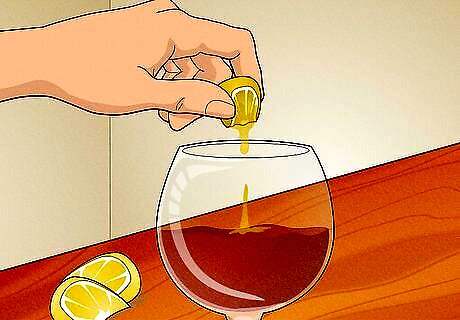
Add lemon to balance the acidity and brighten the flavor of dull wines. Just squeeze the juice from a lemon wedge into your glass and give it a quick stir. Let it sit for a minute before you take another sip and voilà! You’ll have a crisper, more refreshing wine. The scent of lemon will mix with the wine’s natural aromas, which helps balance the wine and lemon flavors. Lime juice will work in a pinch, but not as effectively because it doesn’t have as much citric acid.
Mix a pinch of sugar into acidic wines.
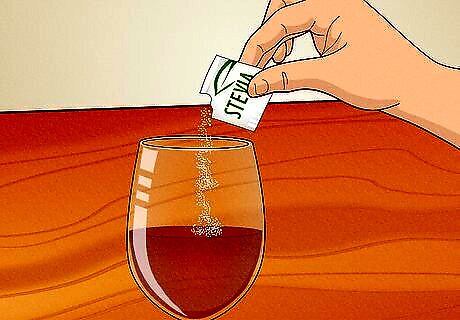
If your wine tastes thin or acidic, sweetness will balance out the flavor. Try adding tiny pinches of sugar to your glass, tasting the wine between each pinch until you find a taste you enjoy. Try granulated sugar, Stevia, or even simple syrup (although this will also water the wine down a bit). The best sweetener is unfermented grape juice. Look for grape juice with no added preservatives or sugar at the grocery store.
Add carbonation to make a spritzer.

Bubbles and ice can make a big difference in the taste of your wine. To make a spritzer, add a splash of club soda to reds, whites, or rosés to liven the flavor and add some texture. If you want to get fancy with it, add berry flavored seltzer water to reds and rosés, or lemon or pear flavors to whites. Add as much carbonation to your wine as you like. A good place to start is 1 part soda water to 2 parts wine.
Make a Calimocho with red wine.

Calimocho is a Spanish drink made from red wine and Coca-Cola. It’s a refreshing beverage that tastes almost like a spicy cherry cola. Pour equal amounts of Coke and red wine over ice and you’re ready to drink! A lime wedge adds a nice touch, too. Feel free to adjust the proportions of Coke to wine to your liking. Calimocho is also spelled as “kalimotxo” in some regions of Spain.
Add acidic fruits to white wine.
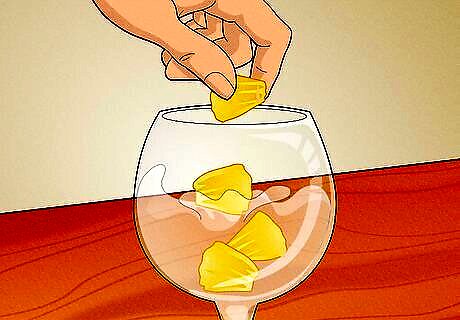
Acidic, fruity flavors can really make a dull white wine pop. Try adding pineapple chunks for a strong, tropical flavor, pomegranate seeds for a delicious (and pretty looking) beverage, or lemonade for a smooth, refreshing cocktail. A splash of club soda and some ice takes it to the next level.
Make a tasty red or white sangria.
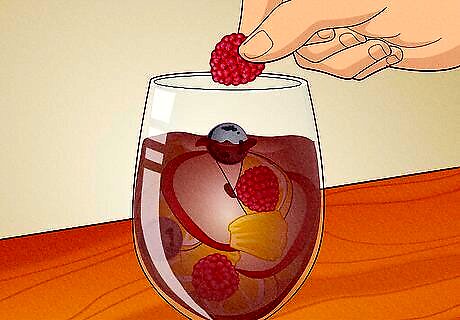
Even a bad wine can make a tasty batch of refreshing sangria. In a pinch, add some chopped fruit to your glass of red—anything works, but apples, citrus, and berries are delicious. If you plan to make sangria ahead of time, a splash of brandy and orange juice makes it more traditional. For a white sangria, add fruits like lemons, limes, peaches, or green apples with apple brandy and cane sugar. There are a lot of ways to make a tasty, refreshing sangria. Next time it’s hot outside, do a quick search online and try out a tempting recipe!
Turn red wine into mulled wine.

Mulled wine is a hot drink made with wine, fruit, and spices. The flavor of the wine gets lost among the other ingredients, so you don’t have to worry about the taste you don’t like cutting through. Simmer red wine with brandy, fruit, and spices for a cozy, holiday drink. Try simmering a bottle of red with clementine slices, 1 cinnamon stick, 1 star anise, 3 dried figs, 4 cloves, 3 whole peppercorns, and 50 mL (0.2 cups) of brandy. Fish out the whole spices and enjoy! Try adding blueberries, cinnamon, and clove to make German Glühwein. There are a ton of mulled wine recipes online—do a quick search and find one that looks appealing!
Eat spicy food with wine that’s too sweet.

Spicy food distracts your taste buds from fully interacting with bad wine. This is especially true for most white wines and reds that are way too sweet. The sweetness of the wine also makes super spicy foods more palatable, so load up on hot sauce or order that extra-spicy curry you’ve been wanting to try. Try hot cuisine like Indian or Thai food, Spanish chorizo, spicy salami, gumbo, or spicy soups.
Pair overly smoky wines with barbecue.
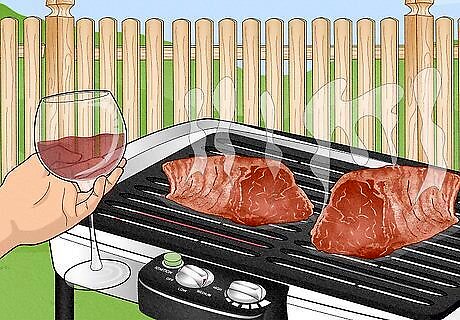
Grilled or smoked food balances out wine that tastes too oaky or smoky. Some wines are exposed to teabags of charred wood chips before they’re bottled, resulting in a smoky flavor. To make it tastier, invite some friends over for a grill out—that wine will be a lot more delicious with a burger or a rack of ribs!
Nibble on cheese between sips.

Cheese has a strong, savory flavor that compliments almost all wines. Snack on a piece between sips and notice how you perceive the wine differently. Bad reds will taste less bitter or acidic and smell fruitier, and whites become more fragrant without losing sweetness. There’s a lot of science and history behind wine and cheese pairings, but to sum it up—pretty much any assortment of cheeses will make any wine taste better. There’s little evidence of any cheese that makes wine taste worse, so feel free to grab your favorite and go to town!
Pair bad red wine with savory foods.

Savory and high-protein foods counteract that cheap red wine taste. Try pairing your troublesome red with red meat, mushrooms, spiced stews, seafood, or other high-protein dishes. It’ll make you look fancy and make your wine more drinkable at the same time! Other good food pairing options could be pork dishes, pizza, or pasta with red sauce.
Drop a penny in your glass.
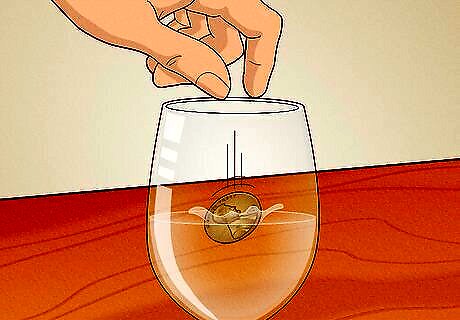
Copper takes away the sulfur smell of bad wine. Wash a copper penny really well and drop into your glass. Swish it around for a few seconds, then fish it out. The copper reacts with smelly thiol compounds and makes them odorless. Since smell guides our sense of taste, a better smelling wine will taste better too. If you can, use a penny made before 1982 (modern pennies have less copper in them, but will still work to some degree).




















Comments
0 comment